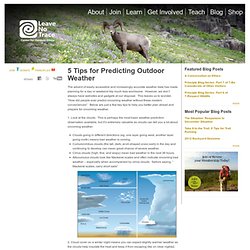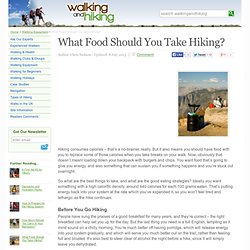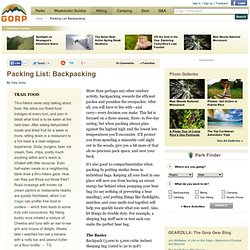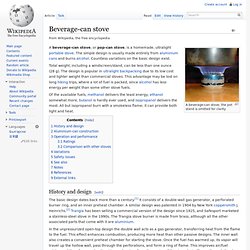

5 Tips for Predicting Outdoor Weather. The advent of easily accessible and increasingly accurate weather data has made planning for a day or weekend trip much less worrisome.

However, we don’t always have websites and gadgets at our disposal. This leaves us to wonder, “How did people ever predict oncoming weather without these modern conveniences”. Below are just a few key tips to help you better plan ahead and prepare for oncoming weather. 1. Look at the clouds. Clouds going in different directions (eg. one layer going west, another layer going north) means bad weather is coming. 2. If the grass is dry, this usually indicates clouds or a strong breeze, which can mean rain. 3.
If you see a red-ish sky at sunset (when looking to the west), there is a high pressure system with dry air stirring dust particles which make the sky appear red. 4. This is caused by the rising sun’s rays from the east striking moisture in the west. 5. If birds are flying high in the sky, there will probably be fair weather. What Food Should You Take Hiking? - Walking And Hiking (UK) Author: Chris Nickson - Updated: 8 July 2013| Comment Hiking consumes calories – that’s a no-brainer, really.

But it also means you should have food with you to replace some of those calories when you take breaks on your walk. Now, obviously that doesn’t meant loading down your backpack with burgers and chips. You want food that’s going to give you energy, and also something that can sustain you if something happens and you’re stuck out overnight. So what are the best things to take, and what are the good eating strategies?
Before You Go Hiking People have sung the praises of a good breakfast for many years, and they’re correct – the right breakfast can help set you up for the day. You also need to make sure you have ample water with you – and drink it while you walk. Good Hiking Foods Chocolate can provide a good burst of energy, of course, so it’s worth having a small bar or two at the bottom of your backpack. What about energy bars? Food For Longer Hikes You might also like... Title: Zen Backpacking - Ultralightweight Backpacking Packing List. Contact: Ultralightweight Backpacking Packing List For backpacking, less is more.

Traveling ultralight means that you carry just enough to stay alive and have move easily since you only carry a feather weight pack. Instead of figuring out what you can do without, sit down and figure out what you must have and can't do without. Reexamine your list and determine what you can do to replace two items with a single item and how you can make each item or system lighter. The amount of gear needed for 1 weeks is the same for 3 months.
Please feel free to link to this site so that others can find it. Long-distance trails in the United States. Essential backpacker trails. Practical Advice - Backpacking: A Packing List. Trail Food Thru-hikers never stop talking about food.

We relive our finest food indulges at every turn, and plan in detail what food is to be eaten at the next town. After eating dehydrated meals and dried fruit for a week or more, sitting down in a restaurant to a hot meal is a near-religious experience. Soda, burgers, beer, ice cream, fries, chips, pretty much anything within arm's reach is inhaled with little recourse. Even half-eaten meals on a neighboring table draw a thru-hikers gaze. Advertisement More than perhaps any other outdoor activity, backpacking rewards the efficient packer and punishes the overpacker. It's also good to compartmentalize when packing by putting similar items in individual bags. The BasicsBackpack (3,000 to 5,000 cubic inches)Sleeping bag (rated to 20 to 50F)Sleeping padTwo-person tent/tarp *Indicates optional/depending on climate and geography.
Beverage-can stove. A beverage-can stove; the pot stand is omitted for clarity A beverage-can stove, or pop-can stove, is a homemade, ultralight portable stove.

The simple design is usually made entirely from aluminium cans and burns alcohol. Countless variations on the basic design exist. Total weight, including a windscreen/stand, can be less than one ounce (28 g). The design is popular in ultralight backpacking due to its low cost and lighter weight than commercial stoves. Of the available fuels, methanol delivers the least energy, ethanol somewhat more, butanol is hardly ever used, and isopropanol delivers the most. History and design[edit] The basic design dates back more than a century.[1] It consists of a double-wall gas generator, a perforated burner ring, and an inner preheat chamber. In the unpressurized open-top design the double wall acts as a gas generator, transferring heat from the flame to the fuel. Aluminium-can construction[edit] Sleeping bag hammock will keep you warm in the wild.